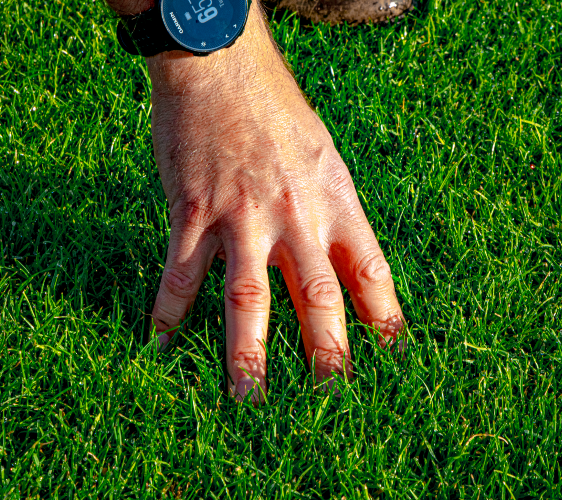- Lawn Turf
- Artificial
- Soil
- Timber
- Composite Decking
- Paving & Stone
Get In Touch With Our Experts Today!
Give us a Call! - Seed & Fertiliser
- Dressing
- Bark

June 04, 2024
Lawn Turfing
Whether you’re creating a new lawn from scratch or replacing an old one, understanding the types of turf available, how to prepare and lay the turf, and how to care for it properly is essential for achieving a healthy, long-lasting lawn.
This guide will explore the different types of lawn turf. Plus provide a step-by-step process for laying turf, and offer expert tips on caring for your newly laid lawn.
Before you begin, choosing the right turf type to achieve the desired aesthetic and performance is essential. Consider factors such as the amount of sunlight the area receives, soil type, and intended use of the lawn.
Read our ultimate guide to turf rolls for more information on choosing the right lawn turf for your garden.
Correctly lawn turfing is crucial to achieving a seamless lawn. Follow these steps to prepare the ground effectively and lay your turf:
Our recent guide provides an in-depth, easy-to-follow process on correctly turfing your lawn.
Various pests can cause significant damage to your lawn, leading to unsightly patches, weakened grass, and increased susceptibility to diseases. By understanding the types of pests that threaten your lawn and implementing effective prevention strategies, you can ensure your lawn remains lush and vibrant throughout the year. Common lawn pests include:
Effective pest prevention not only preserves the aesthetic appeal of a lawn but also promotes robust growth, reduces disease risk, enhances soil health, and minimises maintenance costs. Here are some pest prevention methods to consider:
By understanding the types of pests that threaten your lawn and implementing a combination of prevention and control methods with regular monitoring, you can protect your turf from damage and ensure it thrives throughout the year.
Each season in the UK presents unique challenges and opportunities for lawn care. From fostering new growth in spring to protecting against harsh conditions in Winter. By tailoring your lawn care practices to the specific needs of each season, you can maintain a healthy, vibrant lawn year-round.
Spring is a time of renewal and growth for your lawn. After the dormancy of Winter, your turf needs a boost to kickstart its growth. Over Winter, dead grass, leaves, and other organic matter can build up on the surface of your lawn, forming a layer known as thatch. Thatch can prevent water, air, and nutrients from reaching the soil and roots. Use a spring-tine rake or a mechanical scarifier to remove this layer, allowing better air and nutrient penetration and encouraging new growth.
Once the thatch has been removed, apply a balanced, slow-release fertiliser that provides essential nutrients like nitrogen, phosphorus, and potassium. This helps promote lush, green growth and strengthens the grass to withstand the upcoming summer months.
Summer brings warmer temperatures, pests, and often drier conditions, which can stress and damage your lawn. During these months, it’s essential to water your lawn deeply and less frequently, as frequent shallow watering encourages shallow root growth, making it more susceptible to drought. By Watering your lawn deeply, you ensure the water penetrates at least 6 inches into the soil, encouraging deeper root growth and making the lawn more drought-resistant.
To help your lawn become less susceptible to drought and heat damage, adjust your mower to a higher setting to allow the grass to grow a bit taller. This shades the soil, reducing evaporation and helping to keep the roots cool
Autumn is all about preparing and strengthening your lawn for the Winter ahead. Before the cooler months, aerate your lawn by creating small holes throughout the turf using a garden fork or mechanical aerator. Then, apply a top dressing of sand, loam, and compost to improve soil structure and drainage.
Next, apply a specialised Autumn fertiliser with lower nitrogen and higher potassium content. This helps strengthen the grass roots and prepare the lawn for Winter.
Finally, it’s important to regularly rake and remove fallen leaves from your lawn. Accumulated leaves can block sunlight and trap moisture, creating conditions for fungal diseases.
Winter can be harsh on lawns due to frost, snow, and reduced growth, so protecting your lawn and preventing damage is essential during these months. Walking on frosty or wet grass can damage the turf and compact the soil, leading to bare patches and poor drainage. For this reason, try to limit the use of your lawn during the Winter months. Although we advise using your lawn as little as possible during the Winter. It isimportant to regularly clear any fallen leaves as these can harbour pests and diseases and smother the grass.
By following these guidelines, lawn turfing, caring for, and enjoying a beautiful, healthy lawn for years to come. Remember, consistent care and attention are key to a thriving lawn, particularly during establishment and seasonal changes.
CALL US NOW ON 01234 818 253